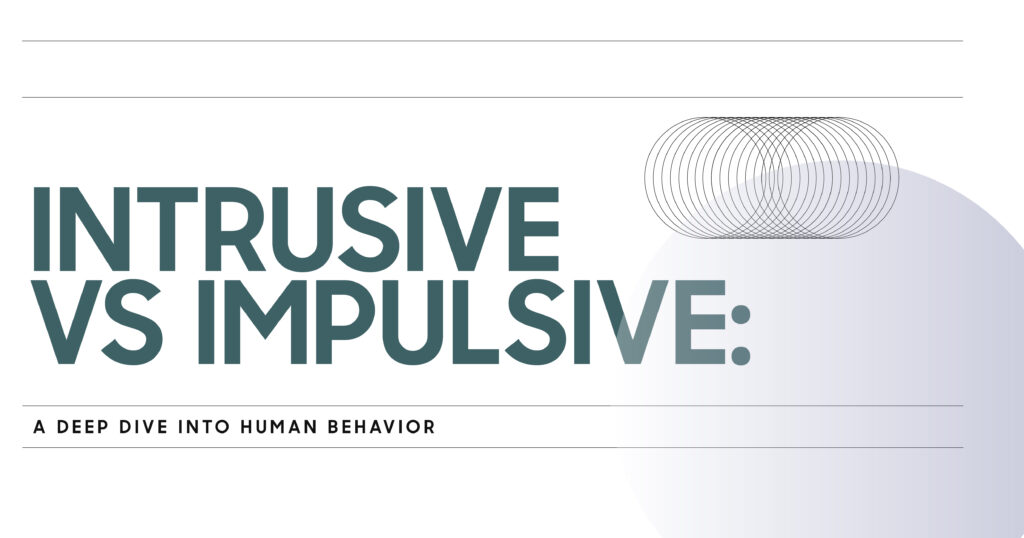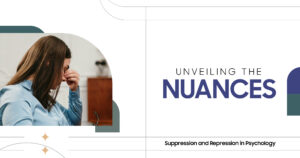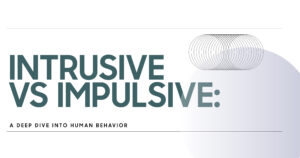Human behavior is a complex tapestry woven from thoughts, emotions, and actions. Two phenomena that often shape our mental landscape are intrusive thoughts and impulsive behavior. While both influence how we navigate daily life, they differ significantly in their origins and effects.
This blog goes into the nuances of intrusive vs impulsive, exploring their roles in cognitive patterns, mental health, and emotional regulation. By understanding these concepts, we can better manage obsessive tendencies, spontaneous actions, and the decision-making process.
Understanding Intrusive Thoughts and Impulsive Behavior
Intrusive thoughts are unwanted, often distressing ideas or images that pop into the mind without invitation. They might involve fears of harm or socially inappropriate scenarios, like shouting in a quiet room. Impulsive behavior, conversely, refers to spontaneous actions taken without forethought, such as making a sudden purchase or interrupting a conversation.
Key distinctions include:
- Intrusive Thoughts: Involuntary, often repetitive, and tied to anxiety or obsessive tendencies.
- Impulsive Behavior: Voluntary but poorly planned, driven by immediate desires or emotions.
- Mental Health Impact: Both can disrupt emotional well-being, but intrusive thoughts lean toward internal distress, while impulsive behavior affects external interactions.
The American Psychological Association notes that intrusive thoughts are common in conditions like obsessive-compulsive disorder, while impulsive behavior may align with disorders like ADHD. Recognizing these patterns is crucial for addressing their impact on mental health.
Cognitive Patterns and Their Role
Cognitive patterns shape how we process thoughts and actions. Intrusive thoughts often stem from obsessive tendencies, where the mind fixates on unwanted ideas, creating a cycle of anxiety. For example, someone might obsess over whether they locked the door, despite checking multiple times. Impulsive behavior, however, arises from spontaneous cognitive patterns, bypassing deliberate reasoning.
The table below compares their cognitive underpinnings:
| Aspect | Intrusive Thoughts | Impulsive Behavior |
| Cognitive Origin | Overactive worry, obsessive loops | Lack of premeditation |
| Trigger | Anxiety, stress, or trauma | Immediate stimuli or emotional surges |
| Example | Fear of contamination | Blurting out a comment without thinking |
| Mental Process | Repetitive, involuntary | Quick, reactive |
These patterns influence how individuals approach decision-making. Intrusive thoughts can paralyze choices by flooding the mind with doubts, while impulsive behavior may lead to rash decisions with unintended consequences.
Impact on Decision-Making Process
Intrusive thoughts can significantly disrupt the decision-making process. They create mental noise, making it hard to focus on logical choices. For instance, someone with intrusive thoughts about failure might avoid taking risks, even when opportunities are promising. This hesitation can stall personal or professional growth.
Impulsive behavior, on the other hand, accelerates decision-making, often at the cost of thorough evaluation. An impulsive individual might agree to a major commitment, like signing a contract, without reviewing the terms. While this spontaneity can feel liberating, it risks regret or conflict.
The National Institute of Mental Health highlights that both phenomena can strain mental health if left unaddressed. Balancing these tendencies requires strategies to enhance emotional regulation and cognitive clarity.

Emotional Regulation as a Management Tool
Emotional regulation is the ability to manage and respond to emotions in a healthy way. For intrusive thoughts, regulation involves acknowledging their presence without letting them dominate. Techniques like mindfulness or cognitive-behavioral therapy (CBT) help individuals reframe these thoughts, reducing their intensity. The Mayo Clinic emphasizes CBT’s effectiveness in breaking obsessive cycles.
For impulsive behavior, emotional regulation focuses on pausing before acting. Strategies like deep breathing or the “10-second rule” (waiting 10 seconds before deciding) can curb spontaneous actions. These approaches foster self-control, aligning actions with long-term goals.
The table below outlines regulatory strategies:
| Strategy | Intrusive Thoughts | Impulsive Behavior |
| Core Technique | Mindfulness, CBT | Pause-and-reflect methods |
| Goal | Reduce thought intensity | Delay impulsive reactions |
| Example Practice | Journaling to externalize thoughts | Counting to 10 before responding |
| Outcome | Decreased anxiety | Improved decision-making |
By integrating these strategies, individuals can mitigate the disruptive effects of intrusive and impulsive tendencies, enhancing mental health.
Distinguishing Intrusive vs Impulsive Patterns
Recognizing whether a thought or action is intrusive or impulsive is the first step toward effective management. Intrusive thoughts often feel foreign or alarming, as if they don’t belong to the individual’s core self. They persist despite efforts to dismiss them. Impulsive behavior, however, feels driven by an immediate urge, often accompanied by a sense of excitement or relief in the moment.
Practical steps to differentiate include:
- Self-Reflection: Ask, “Did I choose this thought/action, or did it feel automatic?”
- Pattern Tracking: Note when thoughts or behaviors occur and their triggers.
- Professional Guidance: Therapists can help identify underlying cognitive patterns.
Understanding these distinctions empowers individuals to tailor their coping strategies, whether through therapy, lifestyle changes, or self-awareness practices.
Washington’s Way to Wiser Choices
Navigating the complexities of intrusive thoughts and impulsive behavior is a journey toward self-discovery and growth. At Treat Washington, we’re dedicated to helping you understand your cognitive patterns and build effective emotional regulation strategies. Whether you’re grappling with obsessive tendencies or seeking to curb spontaneous actions, our team is here to support your mental health. Contact Treat Washington today to explore personalized solutions or learn more about managing your unique behavioral landscape.

FAQs
What are the key differences between intrusive thoughts and impulsive behaviors in mental health?
Intrusive thoughts are involuntary, distressing ideas that disrupt mental peace, often linked to anxiety or obsessive tendencies. Impulsive behaviors are spontaneous actions taken without forethought, driven by immediate emotions. Both impact mental health but require different management approaches, such as therapy for intrusive thoughts and self-control techniques for impulsivity.
How do cognitive patterns contribute to obsessive tendencies and spontaneous actions?
Cognitive patterns shape how thoughts and actions emerge. Obsessive tendencies arise from repetitive, anxiety-driven thought loops, fueling intrusive thoughts. Spontaneous actions stem from quick, reactive cognitive processes, leading to impulsive behavior that bypasses careful consideration.
In what ways can intrusive thoughts impact the decision-making process?
Intrusive thoughts flood the mind with doubts or fears, making it hard to focus on rational choices. They can lead to indecision or avoidance of risks, stalling personal growth. Addressing these thoughts through therapy or mindfulness can restore clarity in decision-making.
How does emotional regulation help manage intrusive thoughts and impulsive behavior?
Emotional regulation helps individuals acknowledge intrusive thoughts without being overwhelmed, using techniques like mindfulness to reduce their intensity. For impulsive behavior, it promotes pausing before acting, fostering better self-control. These strategies enhance mental health by aligning thoughts and actions with long-term goals.
Are there effective strategies to distinguish between intrusive and impulsive cognitive patterns?
Yes, self-reflection and tracking triggers can help differentiate intrusive thoughts, which feel involuntary and distressing, from impulsive behaviors, which are driven by immediate urges. Journaling or consulting a therapist can clarify these patterns. Tailoring coping strategies based on this understanding improves emotional regulation and mental well-being.






